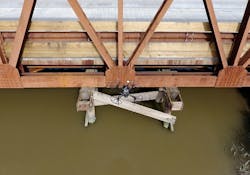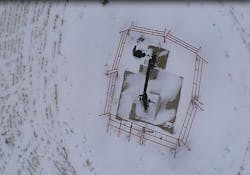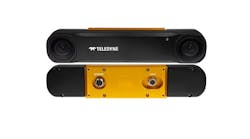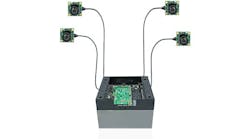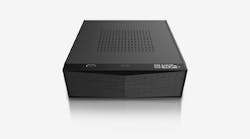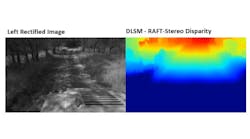In this week’s article from the Association for Unmanned Vehicle Systems International (AUVSI), which highlights some of the latest news and headlines in unmanned vehicles and robotics, we take a look at the "semi-public" U.S. debut of the Amazon Prime Air delivery UAS, a $1 million unmanned systems competition, and some additional beyond line of sight drone testing.
Amazon Prime Air delivery UAS makes semi-public U.S. debut
In what is being described as a "semi-public U.S. debut," an Amazon Prime Air delivery UAS delivered a package containing sunscreen to a resort in Palm Springs, California. The debut came during Amazon’s MARS 2017 conference, which aims to showcase technologies in Machine learning, home Automation, Robotics and Space exploration, before a select audience.
During the demonstration, the quadcopter UAS flew over a lawn at the resort, landed on a target square and dropped off its package before flying away. Caltech researcher Christine Corbett Moran, who was in attendance for the event, reported that the package contained sunscreen.
Whenever the Prime Air delivery service goes commercial, delivery UAS are expected to make deliveries of packages in 30 minutes or less., while travelling at top speeds of 50 mph.
AutoModality wins $1 Million grand prize in Genius NY business competition for unmanned systems
A seven-judge panel has awarded the $1 million grand prize in the Genius NY business competition to AutoModality. The money will be used to hire new employees, according to AutoModality's chief technology officer and one of its three principals Ed Koch.
AutoModality’s UAS can get within three feet of objects to conduct up-close inspections of buildings, bridges, power lines and other structures. Instead of using GPS, computerized optics are used to control the movements of the UAS, helping them avoid collisions with other objects.
AutoModality beat out five other finalists vying for the first-place prize, but the other competitors each received prizes as well.
A second-place prize of $600,000 was awarded to a company called Ascent AeroSystems, which make UAS that can be carried in backpacks. A third-place prize of $400,000 was awarded to a company called OmniMesh, which is designing a wireless network protocol that is meant to increase UAS safety and security.
Three runner-ups received prizes of $250,000 each.
Drone Technologies conducts first BLOS flight in New Zealand
On Feb. 24, Drone Technologies Ltd., a company based in Taranaki, New Zealand,completed the first beyond-line-of-sight (BLOS) UAS flight in New Zealand, as the company used an Aerosonde fixed-wing UAS to survey a 30-kilometer section of Transpower’s transmission lines and towers in the Rimutaka Ranges.
During the mission, the UAS captured close-up footage of towers and lines, as it hovered close to the structures. The 25 kilogram UAS, with a 3.5 meter wingspan, covered 100 kilometers during the 54-minute flight.
The New Zealand Civil Aviation Authority made the flight possible, thanks to its new "beyond line of sight framework," which has opened the country’s airspace for UAS under strict conditions.
The flight, which was controlled by a team on the ground, was carried out the same way a manned flight would be carried out, as permission had to be gained to conduct the flight at the specific time, the flight had to have a flight plan, and the pilots had to be trained thoroughly beforehand.
Transpower will use the data collected from the flights to determine if they will use UAS on a regular basis to monitor their transmission lines and equipment.
Canadian UAVs and Lockheed Martin conduct first BVLOS UAS inspections of pipelines and power lines in Canada
Canadian UAVs and Lockheed Martin CDL Systems haveconducted the first beyond-line-of-sight inspectionsusing UAS in Canada, at the Foremost Centre for Unmanned Systems in Alberta.
Using Lockheed Martin’s Indago 2 UAS, which was compliant with Transport Canada, several pipelines, well sites and power lines were inspected during the flights.
"Canadian UAVs has been focused on creating an end-to-end paradigm in coordination with Transport Canada to conduct these operations outside of Restricted Military Airspace where our customers have a substantial regulatory and logistical needs to acquire actionable data," says Canadian UAVs Inc. President Sean Greenwood.
"Due to our in-house combined military and commercial, manned and unmanned aviation backgrounds, the most advanced Lockheed Martin unmanned aircraft systems and a constant drive to evolve our aerial solutions, we have been able to demonstrate today the most logical operating structure for BVLOS on the market."
John Molberg, Business Development lead for Lockheed Martin CDL Systems, adds, "this flight achievement is a bellwether for Canadian UAVs, Lockheed Martin and Foremost Test Range, while also showcasing the leadership provided by Unmanned Systems Canada and Transport Canada for the safe use of unmanned systems in Canadian airspace."
View more information on the AUVSI.
Share your vision-related news by contacting James Carroll, Senior Web Editor, Vision Systems Design
To receive news like this in your inbox, click here.
Join our LinkedIn group | Like us on Facebook | Follow us on Twitter
Learn more: search the Vision Systems Design Buyer's Guide for companies, new products, press releases, and videos

